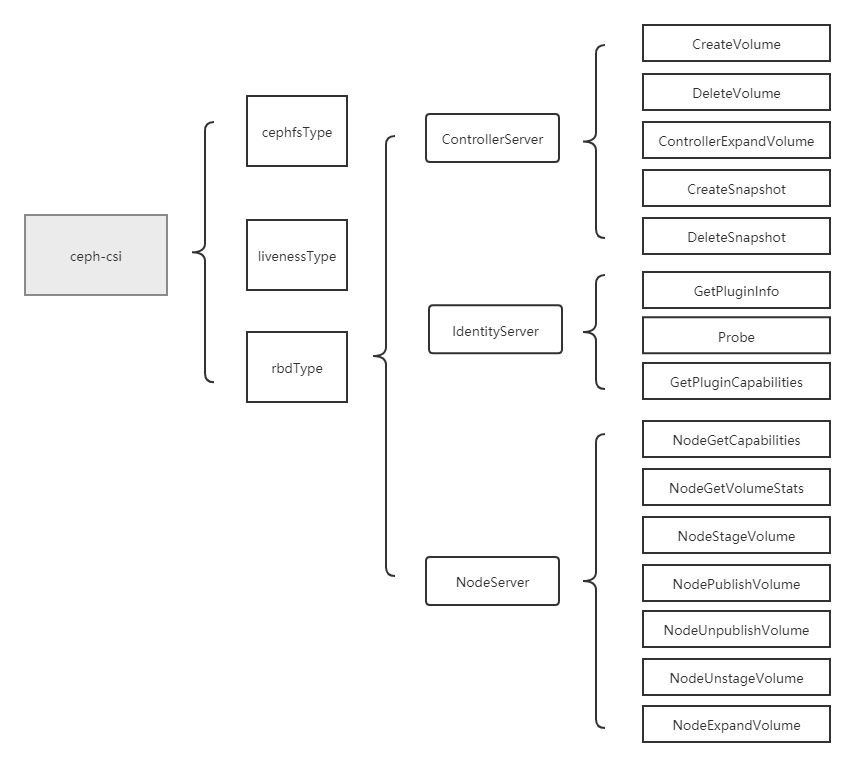kubernetes ceph-csi 分析 - 目录导航:
https://xie.infoq.cn/article/4b1d3e32f124307a49cd9c1e3
当 ceph-csi 组件启动时指定的 driver type 为 rbd 时,会启动 rbd driver 相关的服务。然后再根据controllerserver、nodeserver的参数配置,决定启动ControllerServer与IdentityServer,或NodeServer与IdentityServer。
基于 tag v3.0.0
https://github.com/ceph/ceph-csi/releases/tag/v3.0.0
rbd driver 分析将分为 4 个部分,分别是服务入口分析、controllerserver 分析、nodeserver 分析与 IdentityServer 分析。
这节进行 nodeserver 分析,nodeserver 主要包括了 NodeGetCapabilities(获取 driver 能力)、NodeGetVolumeStats(存储探测及 metrics 获取)、NodeStageVolume(map rbd 与 mount stagingPath)、NodePublishVolume(mount targetPath)、NodeUnpublishVolume(umount targetPath)、NodeUnstageVolume(umount stagingPath 与 unmap rbd)、NodeExpandVolume(node 端存储扩容)操作,将一一进行分析。这节进行 NodeGetCapabilities(获取 driver 能力)、NodeGetVolumeStats(存储探测及 metrics 获取)、NodeExpandVolume(node 端存储扩容)的分析。
nodeserver 分析
(1)NodeGetCapabilities
简介
NodeGetCapabilities 主要用于获取该 ceph-csi driver 的能力。
该方法由由 kubelet 调用,在 kubelet 调用 NodeExpandVolume、NodeStageVolume、NodeUnstageVolume 等方法前,会先调用 NodeGetCapabilities 来获取该 ceph-csi driver 的能力,看是否支持对这些方法的调用。
kubelet 中调用的有关代码位于pkg/volume/csi/csi_client.go。
NodeGetCapabilities
NodeGetCapabilities 方法中注册了 csi driver 的能力。
如下代码表示该 csi 组件支持的能力有:
(1)挂载存储到节点,把存储从节点上解除挂载;
(2)获取节点上的存储状态;
(3)存储扩容。
// ceph-csi/internal/rbd/nodeserver.go
// NodeGetCapabilities returns the supported capabilities of the node server.func (ns *NodeServer) NodeGetCapabilities(ctx context.Context, req *csi.NodeGetCapabilitiesRequest) (*csi.NodeGetCapabilitiesResponse, error) { return &csi.NodeGetCapabilitiesResponse{ Capabilities: []*csi.NodeServiceCapability{ { Type: &csi.NodeServiceCapability_Rpc{ Rpc: &csi.NodeServiceCapability_RPC{ Type: csi.NodeServiceCapability_RPC_STAGE_UNSTAGE_VOLUME, }, }, }, { Type: &csi.NodeServiceCapability_Rpc{ Rpc: &csi.NodeServiceCapability_RPC{ Type: csi.NodeServiceCapability_RPC_GET_VOLUME_STATS, }, }, }, { Type: &csi.NodeServiceCapability_Rpc{ Rpc: &csi.NodeServiceCapability_RPC{ Type: csi.NodeServiceCapability_RPC_EXPAND_VOLUME, }, }, }, }, }, nil}
复制代码
(2)NodeGetVolumeStats
简介
NodeGetVolumeStats 用于探测挂载存储的状态,并返回该存储的相关 metrics 给 kubelet。
由 kubelet 定时循环调用,获取 volume 相关指标。kubelet 定时调用的代码位于pkg/kubelet/server/stats/volume_stat_calculator.go-StartOnce()。
NodeGetVolumeStats
主要逻辑:
(1)获取存储挂载路径;
(2)检测存储挂载路径是否为挂载点(对比指定路径与其父目录的 stat 结果中的 device 的值,如果 device 值不一致,则是挂载点);
(3)通过 stat 获取存储挂载路径的 Metrics 并返回。
// internal/csi-common/nodeserver-default.go
// NodeGetVolumeStats returns volume stats.func (ns *DefaultNodeServer) NodeGetVolumeStats(ctx context.Context, req *csi.NodeGetVolumeStatsRequest) (*csi.NodeGetVolumeStatsResponse, error) { // 获取存储挂载路径 var err error targetPath := req.GetVolumePath() if targetPath == "" { err = fmt.Errorf("targetpath %v is empty", targetPath) return nil, status.Error(codes.InvalidArgument, err.Error()) } /* volID := req.GetVolumeId()
TODO: Map the volumeID to the targetpath.
CephFS: we need secret to connect to the ceph cluster to get the volumeID from volume Name, however `secret` field/option is not available in NodeGetVolumeStats spec, Below issue covers this request and once its available, we can do the validation as per the spec.
https://github.com/container-storage-interface/spec/issues/371
RBD: Below issue covers this request for RBD and once its available, we can do the validation as per the spec.
https://github.com/ceph/ceph-csi/issues/511
*/ // 检测存储挂载路径是否为mountpoint isMnt, err := util.IsMountPoint(targetPath)
if err != nil { if os.IsNotExist(err) { return nil, status.Errorf(codes.InvalidArgument, "targetpath %s doesnot exist", targetPath) } return nil, err } if !isMnt { return nil, status.Errorf(codes.InvalidArgument, "targetpath %s is not mounted", targetPath) } // 通过stat获取存储挂载路径的Metrics cephMetricsProvider := volume.NewMetricsStatFS(targetPath) volMetrics, volMetErr := cephMetricsProvider.GetMetrics() if volMetErr != nil { return nil, status.Error(codes.Internal, volMetErr.Error()) }
available, ok := (*(volMetrics.Available)).AsInt64() if !ok { klog.Errorf(util.Log(ctx, "failed to fetch available bytes")) } capacity, ok := (*(volMetrics.Capacity)).AsInt64() if !ok { klog.Errorf(util.Log(ctx, "failed to fetch capacity bytes")) return nil, status.Error(codes.Unknown, "failed to fetch capacity bytes") } used, ok := (*(volMetrics.Used)).AsInt64() if !ok { klog.Errorf(util.Log(ctx, "failed to fetch used bytes")) } inodes, ok := (*(volMetrics.Inodes)).AsInt64() if !ok { klog.Errorf(util.Log(ctx, "failed to fetch available inodes")) return nil, status.Error(codes.Unknown, "failed to fetch available inodes") } inodesFree, ok := (*(volMetrics.InodesFree)).AsInt64() if !ok { klog.Errorf(util.Log(ctx, "failed to fetch free inodes")) }
inodesUsed, ok := (*(volMetrics.InodesUsed)).AsInt64() if !ok { klog.Errorf(util.Log(ctx, "failed to fetch used inodes")) } return &csi.NodeGetVolumeStatsResponse{ Usage: []*csi.VolumeUsage{ { Available: available, Total: capacity, Used: used, Unit: csi.VolumeUsage_BYTES, }, { Available: inodesFree, Total: inodes, Used: inodesUsed, Unit: csi.VolumeUsage_INODES, }, }, }, nil}
复制代码
IsMountPoint
通过调用 IsLikelyNotMountPoint 来判断该路径是否为挂载点。
// internal/util/util.go
// IsMountPoint checks if the given path is mountpoint or not.func IsMountPoint(p string) (bool, error) { dummyMount := mount.New("") notMnt, err := dummyMount.IsLikelyNotMountPoint(p) if err != nil { return false, status.Error(codes.Internal, err.Error()) }
return !notMnt, nil}
复制代码
dummyMount.IsLikelyNotMountPoint()主要逻辑:
(1)对指定路径执行 stat 操作;
(2)对指定路径的父目录执行 stat 操作;
(3)通过对比指定路径与其父目录的 stat 结果中的 device 的值,判断出该路径是否为挂载点(如果 device 值不一致,则是挂载点)。
// vendor/k8s.io/utils/mount/mount_linux.go
// IsLikelyNotMountPoint determines if a directory is not a mountpoint.// It is fast but not necessarily ALWAYS correct. If the path is in fact// a bind mount from one part of a mount to another it will not be detected.// It also can not distinguish between mountpoints and symbolic links.// mkdir /tmp/a /tmp/b; mount --bind /tmp/a /tmp/b; IsLikelyNotMountPoint("/tmp/b")// will return true. When in fact /tmp/b is a mount point. If this situation// is of interest to you, don't use this function...func (mounter *Mounter) IsLikelyNotMountPoint(file string) (bool, error) { stat, err := os.Stat(file) if err != nil { return true, err } rootStat, err := os.Stat(filepath.Dir(strings.TrimSuffix(file, "/"))) if err != nil { return true, err } // If the directory has a different device as parent, then it is a mountpoint. if stat.Sys().(*syscall.Stat_t).Dev != rootStat.Sys().(*syscall.Stat_t).Dev { return false, nil }
return true, nil}
复制代码
(3)NodeExpandVolume
简介
负责 node 端的存储扩容操作。主要是在 node 上做相应操作,将存储的扩容信息同步到 node 上。
NodeExpandVolume resizes rbd volumes.
实际上,存储扩容分为两大步骤,第一步是 csi 的 ControllerExpandVolume,主要负责将底层存储扩容;第二步是 csi 的 NodeExpandVolume,当 volumemode 是 filesystem 时,主要负责将底层 rbd image 的扩容信息同步到 rbd/nbd device,对 xfs/ext 文件系统进行扩展;当 volumemode 是 block,则不用进行 node 端扩容操作。
NodeExpandVolume
主体流程:
(1)校验请求参数;
(2)判断指定路径是否为挂载点;
(3)获取 devicePath;
(4)调用 resizefs.NewResizeFs 初始化 resizer;
(5)调用 resizer.Resize 做进一步操作。
func (ns *NodeServer) NodeExpandVolume(ctx context.Context, req *csi.NodeExpandVolumeRequest) (*csi.NodeExpandVolumeResponse, error) { volumeID := req.GetVolumeId() if volumeID == "" { return nil, status.Error(codes.InvalidArgument, "volume ID must be provided") } volumePath := req.GetVolumePath() if volumePath == "" { return nil, status.Error(codes.InvalidArgument, "volume path must be provided") }
if acquired := ns.VolumeLocks.TryAcquire(volumeID); !acquired { klog.Errorf(util.Log(ctx, util.VolumeOperationAlreadyExistsFmt), volumeID) return nil, status.Errorf(codes.Aborted, util.VolumeOperationAlreadyExistsFmt, volumeID) } defer ns.VolumeLocks.Release(volumeID)
// volumePath is targetPath for block PVC and stagingPath for filesystem. // check the path is mountpoint or not, if it is // mountpoint treat this as block PVC or else it is filesystem PVC // TODO remove this once ceph-csi supports CSI v1.2.0 spec notMnt, err := mount.IsNotMountPoint(ns.mounter, volumePath) if err != nil { if os.IsNotExist(err) { return nil, status.Error(codes.NotFound, err.Error()) } return nil, status.Error(codes.Internal, err.Error()) } if !notMnt { return &csi.NodeExpandVolumeResponse{}, nil }
devicePath, err := getDevicePath(ctx, volumePath) if err != nil { return nil, status.Error(codes.Internal, err.Error()) }
diskMounter := &mount.SafeFormatAndMount{Interface: ns.mounter, Exec: utilexec.New()} // TODO check size and return success or error volumePath += "/" + volumeID resizer := resizefs.NewResizeFs(diskMounter) ok, err := resizer.Resize(devicePath, volumePath) if !ok { return nil, fmt.Errorf("rbd: resize failed on path %s, error: %v", req.GetVolumePath(), err) } return &csi.NodeExpandVolumeResponse{}, nil}
复制代码
resizer.Resize
根据相应的文件系统格式,调用相应的 resize 方法。
func (resizefs *ResizeFs) Resize(devicePath string, deviceMountPath string) (bool, error) { format, err := resizefs.mounter.GetDiskFormat(devicePath)
if err != nil { formatErr := fmt.Errorf("ResizeFS.Resize - error checking format for device %s: %v", devicePath, err) return false, formatErr }
// If disk has no format, there is no need to resize the disk because mkfs.* // by default will use whole disk anyways. if format == "" { return false, nil }
klog.V(3).Infof("ResizeFS.Resize - Expanding mounted volume %s", devicePath) switch format { case "ext3", "ext4": return resizefs.extResize(devicePath) case "xfs": return resizefs.xfsResize(deviceMountPath) } return false, fmt.Errorf("ResizeFS.Resize - resize of format %s is not supported for device %s mounted at %s", format, devicePath, deviceMountPath)}
复制代码
xfsResize
xfs 文件系统使用 xfs_growfs 命令。
func (resizefs *ResizeFs) xfsResize(deviceMountPath string) (bool, error) { args := []string{"-d", deviceMountPath} output, err := resizefs.mounter.Exec.Command("xfs_growfs", args...).CombinedOutput()
if err == nil { klog.V(2).Infof("Device %s resized successfully", deviceMountPath) return true, nil }
resizeError := fmt.Errorf("resize of device %s failed: %v. xfs_growfs output: %s", deviceMountPath, err, string(output)) return false, resizeError}
复制代码
extResize
ext 文件系统使用 resize2fs 命令。
func (resizefs *ResizeFs) extResize(devicePath string) (bool, error) { output, err := resizefs.mounter.Exec.Command("resize2fs", devicePath).CombinedOutput() if err == nil { klog.V(2).Infof("Device %s resized successfully", devicePath) return true, nil }
resizeError := fmt.Errorf("resize of device %s failed: %v. resize2fs output: %s", devicePath, err, string(output)) return false, resizeError
}
复制代码
rbd driver-nodeserver 分析(上)-小结
这节分析了NodeGetCapabilities、NodeGetVolumeStats、NodeExpandVolume方法,作用分别如下:
NodeGetCapabilities:获取 ceph-csi driver 的能力。
NodeGetVolumeStats:探测挂载存储的状态,并返回该存储的相关 metrics 给 kubelet。
NodeExpandVolume:在 node 上做相应操作,将存储的扩容信息同步到 node 上。














评论